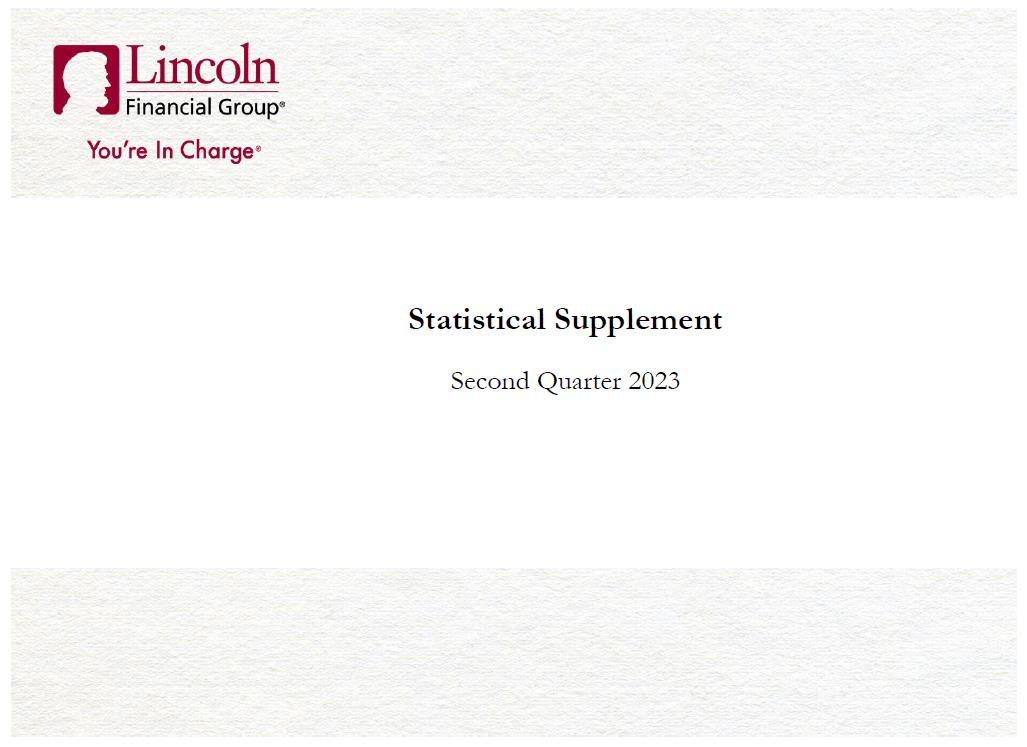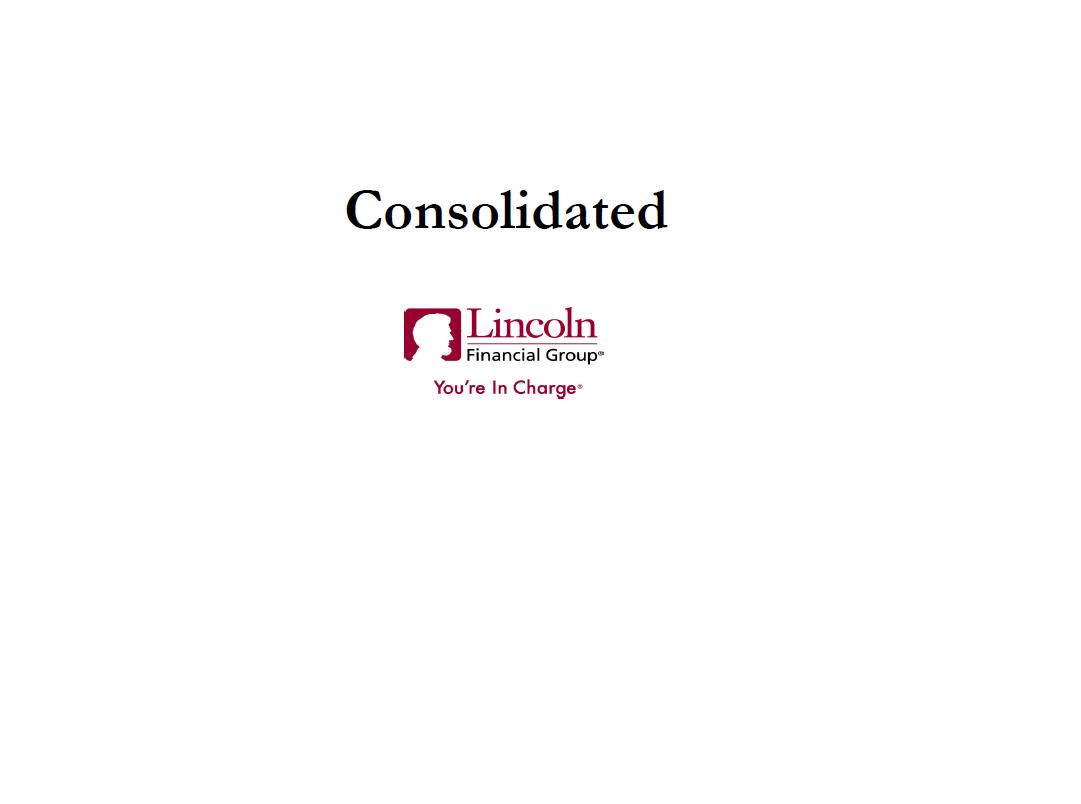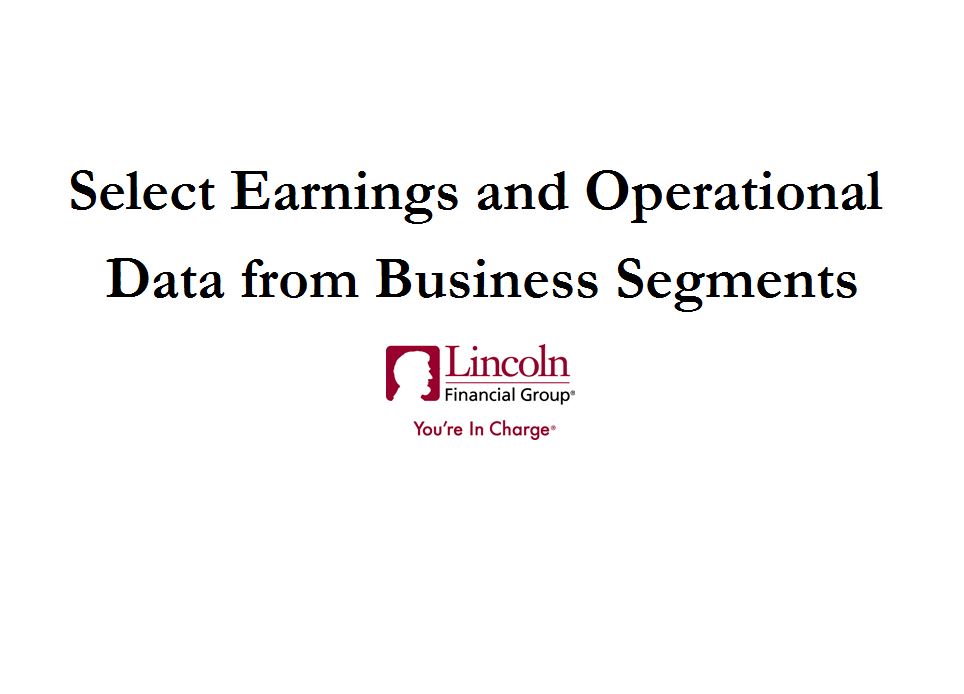| | | | | | | | | | | | | | | | | | | | | | | | | | |
| Lincoln Financial Group | |
| Notes | |
| | |
| | | | | | | | | | | | | | | | | | | | | | | | | | |
| Non-GAAP Performance Measures, Continued | |
| | | | | | | | | | | | | | | | | | | | | | | | | | |
| Stockholders’ Equity, Excluding AOCI and Preferred Stock | |
| Stockholders’ equity, excluding AOCI is stockholders’ equity, excluding AOCI and preferred stock. Management believes this metric is useful to investors because it eliminates market movements that are | |
| unpredictable and can fluctuate significantly from period to period, primarily related to changes in interest rates. Stockholders’ equity is the most directly comparable GAAP measure. | |
| | | | | | | | | | | | | | | | | | | | | | | | | | |
| Adjusted Stockholders’ Equity | |
| For presented periods prior to January 1, 2023, adjusted stockholders’ equity is stockholders’ equity, excluding AOCI, preferred stock and MRB-related impacts. For periods beginning on or after January 1, 2023, | |
| adjusted stockholders’ equity is stockholders’ equity, excluding AOCI, preferred stock, MRB-related impacts and GLB and GDB hedged instruments gains (losses), to align to updates made to our variable | |
| annuity hedge program effective January 1, 2023. Management believes this metric is useful to investors because it eliminates the effect of market movements that are unpredictable and can fluctuate significantly | |
| from period to period, primarily related to changes in equity markets and interest rates. Stockholders’ equity is the most directly comparable GAAP measure. | |
| | | | | | | | | | | | | | | | | | | | | | | | | | |
| Book Value per Share, Excluding AOCI | |
| Book value per share, excluding AOCI, is calculated by dividing stockholders’ equity, excluding AOCI and preferred stock, by common shares outstanding. We provide book value per share, excluding AOCI, to | |
| enable investors to analyze the amount of our net worth that is attributable primarily to our business operations. Management believes book value per share, excluding AOCI, is useful to investors because it | |
| eliminates the effect of items that are unpredictable and can fluctuate significantly from period to period, primarily based on changes in interest rates. Book value per share is the most directly comparable GAAP | |
| measure. | |
| | | | | | | | | | | | | | | | | | | | | | | | | | |
| Adjusted Book Value per Share | |
| Adjusted book value per share is calculated by dividing stockholders’ equity, excluding AOCI, preferred stock and MRB-related impacts, by common shares outstanding. We provide adjusted book value per share | |
| to enable investors to analyze the amount of our net worth that is attributable primarily to our business operations. Management believes adjusted book value per share is useful to investors because it eliminates | |
| the effect of items that are unpredictable and can fluctuate significantly from period to period, primarily based on changes in equity markets and interest rates. Book value per share is the most directly | |
| comparable GAAP measure. | |
| | | | | | | | | | | | | | | | | | | | | | | | | | |
| Adjusted Income (Loss) From Operations Available to Common Stockholders, Excluding AOCI and Preferred Stock ROE | |
| Adjusted income (loss) from operations available to common stockholders, excluding AOCI and preferred stock ROE is calculated by dividing annualized adjusted income (loss) from operations available | |
| to common stockholders by average stockholders’ equity, excluding AOCI and preferred stock. Management believes this metric is useful to investors because it eliminates the effect of market movements | |
| on ROE that are unpredictable and can fluctuate significantly from period to period, primarily related to changes in interest rates. Net income (loss) ROE is the most directly comparable GAAP measure. | |
| | | | | | | | | | | | | | | | | | | | | | | | | | |
| Adjusted Income (Loss) From Operations ROE | |
| Adjusted income (loss) from operations ROE is calculated by dividing annualized adjusted income (loss) from operations available to common stockholders by adjusted average stockholders’ equity. | |
| Management believes this metric is useful to investors because it eliminates the effect of market movements on ROE that are unpredictable and can fluctuate significantly from period to period, primarily | |
| related to changes in equity markets and interest rates. Net income (loss) ROE is the most directly comparable GAAP measure. | |
| | | | | | | | | | | | | | | | | | | | | | | | | | |
| Management believes that the non-GAAP measures discussed above allow for a better understanding of the underlying trends in our current business as the excluded items are unpredictable and not necessarily | |
| indicative of current operating fundamentals or future performance of the business. | |
| | |
| Computations | |
| • The quarterly financial information for the current year may not sum to the corresponding year-to-date amount as both are rounded to millions. | |
| • The financial ratios reported herein are calculated using whole dollars instead of dollars rounded to millions. | |
| • We exclude deferred units of LNC stock that are antidilutive from our diluted earnings per share calculation. In addition, for any period where a net loss or adjusted loss from operations is experienced, shares | |
| used in the diluted EPS calculation represent basic shares, as the use of diluted shares would result in a lower loss per share. | |
| • Pre-tax net margin is calculated by dividing adjusted income (loss) from operations before taxes by net revenue, which is defined as total adjusted operating revenues less interest credited. | |
| | | | | | | | | | | | | | | | | | | | | | | | | | |
| Page 1b | |





